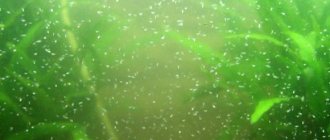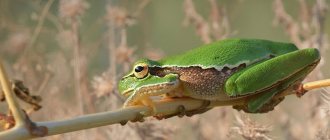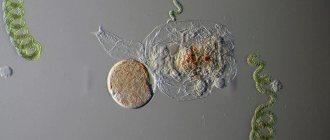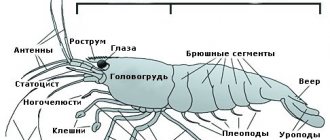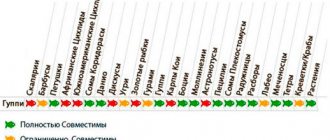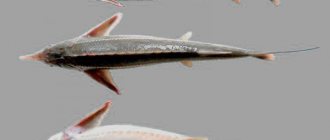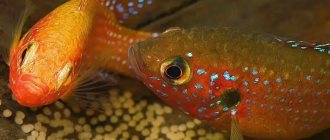The Grindal worm (Enchytraeus) is a member of the Enchytraeidae family and is known to some as milk white worms or “pot worms.” Swedish aquarists first began to use it as a type of live food for their fish.
These opaque white or yellow worms have very short setae (single-toothed) and can grow to 2 cm or more. They like to live in damp areas with rich organic matter (compost heaps, banks of reservoirs) and gather in the form of balls. Without any problems, you can grow them at home and use them as a useful live feed crop.
How to feed fish with Grindal worm?
This food is high in protein, high in energy and is widely used as a valuable additive in the general diet of aquarium inhabitants. They are especially convenient for feeding fry and small fish, especially before spawning. The dry matter of this type of food consists of 70% proteins, 14% fats and 10% carbohydrates, and also contains large amounts of vitamin A and carotene. The composition directly depends on the quality and composition of the feed used and consumed when growing grindal.
It is not recommended to feed adult fish with the Grindal worm for a long time, as they may become obese, and the relatively low content of salts and other vitamins leads to weakened immunity and a decrease in their body’s resistance to typical diseases. Therefore, it is recommended to feed aquarium inhabitants with such high-calorie food not very often, better every other day or a couple of times a week.
When feeding, in order to collect the required number of worms, it is more convenient to use a glass slide and a piece of gauze. First, cover the substrate with gauze to prevent it from sticking to the glass and getting into the water, place the glass on top, and sprinkle oatmeal on the glass. Once the worms have collected on the glass, they can be transferred to the tank using a brush or directly on the glass.
Do not forget to monitor whether worms remain in the container after feeding, since they can live there for no more than a day, and then they will only pollute the water with decomposition products. Therefore, it is advisable to collect the remaining food in the evening using a siphon.
To separate small worms from large ones when feeding the fry, it is convenient to use a glass of water: after mixing the water, the large ones will settle to the bottom, and the small ones will remain in the thickness.
Then you can feed them with tweezers or using special feeders.
www.killi.ru
Breeding food for juveniles at home
Alexander Sukhov, Chelyabinsk Slavic club of spawning carp-tooth lovers
When you have an aquarium farm, but spend a lot of time at work and there is not the slightest opportunity to catch live food for the fry, you have to breed it yourself. Here are ways to easily breed a water snake and a Grindal worm. water snake
(
Aulophorus furcatus
) - is a freshwater representative of sea snakes (
Naididae
). In nature, it inhabits the silted plant zone of water bodies, feeding on dead plants, silt and other inanimate organic matter. The pink worm reaches a length of up to 20 mm with a thickness of about 0.2 mm. It got its name from its sinuous, serpentine movements when moving through the water. Hermaphrodite. Aulophorus can be easily obtained from a natural reservoir by placing a glass jar filled with several pieces of apple, carrot, melon peel and other plant waste in which they will be collected. To prevent the “bait” from falling out of the jar and for worms to easily penetrate it, the neck must be covered with a net. Raising worms is not difficult. To do this, you need a low container with a lid; a plastic container like a herring box, which can be purchased in departments with disposable tableware, is ideal. You need to pour boiled or settled water into the container, place a flat piece of foam rubber on which to put food for the snake, where it will actually collect. Water should be poured so that the foam rubber with food is submerged and the top part is at its level. Food for the snake can be pieces of carrots, banana peels, grass flour, etc. I use oatmeal, which I add in small pinches.
water snake
(
Aulophorus furcatus
)
The hatch cover should be slightly open to avoid the death of the worms and the attenuation of the entire biomass. I put the dishes in a shaded place. Once every 2-3 days I take 2/3 of the aulophorus mass and completely replace the water, and also add flakes if necessary. Protozoa reproduce well in water, which doubles the feasibility of breeding snakes, so I pour the water into separate jars. I check the containers every day; if worms collect on the walls of the container near the surface of the water, this serves as a signal to urgently replace it.
A cut snake is perfectly eaten by week-old fry. Worms can be fed to both fry and adult fish. It is very interesting to observe how the hunting instincts instantly manifest themselves in Afiosemion or Nothobranchius, who see such a miracle writhing in the water column. At the bottom of the aquarium, the snake gathers into balls resembling a tubifex.
Grindal Worm
(
Enchytraeus buchholzi
) is a relative of the common pot plant cultivated by many aquarists. High-calorie, high-protein food for fry and adolescent fish. The worm is white and up to 10mm long. For dilution, you can use any short plastic or other sealed container with a lid. A mesh cut to fit the contour is placed at the bottom; separator or other will do. I use dense pieces of boiled peat as a substrate. You can use foam rubber, but it has one drawback: removing worms is complicated due to the presence of many pores. A 1-2mm layer of water is poured into the bottom of the dish, which will moisten the substrate through the mesh. Food can be oatmeal gruel, oatmeal, powdered milk, but better - small slices of cheese that are placed on top of the peat along with a colony of worms. The container should be placed in a dark place at room temperature.
Grindal Worm
(
Enchytraeus buchholzi
) Fresh worm food should not be added until the previous portion has been consumed. The lid of the container should not be closed tightly to avoid the death of the worms. Once every 2-3 days I wash the worms out of the peat into a separate container, where I rinse them with water to remove any suspended matter and food residues. It is not recommended to constantly feed fish with grindal worm due to its high calorie content, so you need to alternate it with other foods. It can stay alive in water for up to 2 days. Nematodes are a frequent companion when breeding worms, which is very convenient when feeding fry of different ages in the same aquarium.
Aulophorus furcatus
Enchytraeus buchholzi
‹ One of the methods of breeding some species of the genus Fundulopanchax. Up Recommendations. How to keep an observation log. ›
How to breed grindal worm at home?
In their practice, aquarists have learned to use several methods for growing and breeding grindal worms; moreover, there are no difficulties in this matter. By its nature, Enchytraeus is hermaphrodite (not divided into sexes), reaching sexual maturity in about three weeks. The eggs he lays (usually 10 pieces) are placed in a cocoon, the offspring develop within 12 days under certain conditions:
| Temperature range 18-24 degrees | Ideal temperature for breeding |
| Less than 14 degrees | Cessation of vital activity, poor reproduction |
| More than 26 degrees | Possible mites and mold growth |
| More than 30 degrees | The worms will try to leave the container, trying to protect themselves from the heat, and die |
In a warm environment, the substrate quickly loses moisture, so do not forget to periodically spray it with warm water from a spray bottle or simply pour milk (kefir).
Place the breeding containers in a fairly dark place: Enchytraeus does not like to be in bright sunlight.
Breeding methods
Grindal can be grown in any container: either in wood, glass, or in simple plastic trays or containers with a lid, preferably about 10 centimeters high. The use of both smaller and larger containers does not in any way affect the breeding and growing process. Do not forget to leave a small gap of 1-2 cm between the lid and the substrate. And make small holes on the lid, since in a sealed environment the worms will simply suffocate.
You can choose one of the following breeding methods:
- The most widespread method is growing on coconut substrate (coconut fiber).
- Breeding on expanded clay.
- Growing on foam rubber (fine-pored foam).
- Using synthetic batting instead of substrate.
- On scalded long-fiber peat moss (sphagnum).
- They also use mixtures of peat, forest soil and spruce or pine needles, taken in equal proportions.
- Growing on vermiculite, which is a mineral with a layered structure consisting of yellow or brown crystals. Has good water absorption. Simply fill it with water to swell and then use it as usual.
The composition of the substrate itself is not so important; the main thing is that the resulting mixture should be loose and “light.” It should not contain fertilizers or pathogens. To do this, it is best to keep your substrate (moss, peat or other) in a boiling water bath for about one hour to get rid of unnecessary worms, insects and other microorganisms.
In practice, many hobbyists use an integrated approach: a thin layer of expanded clay is placed at the bottom of the container to improve ventilation in the lower part and prevent souring (excess moisture will accumulate there), then a mesh is placed, and the prepared coconut or other substrate is placed on top.
Cultivation on coconut substrate
Pre-soak a briquette of dry coconut crumbs (sold in stores) in water, pour boiling water over it, and squeeze out. To determine the “required” humidity, you can use the following method: when squeezing with your hand, the substrate should form a lump that crumbles with a slight impact.
You can find both large and small coconut substrates on sale. For breeding grindal, the most preferable is the small one, which is looser and lighter.
The layer of soil itself should occupy approximately 2-5 centimeters.
If you are going to breed Grindal for a long time, do not forget to change the substrate once every six months, as unwanted waste accumulates in it. This can be noticed by the appearance of a dark border along the edge of the substrate or by a decrease in the “yield” of the culture.
Breeding on foam rubber
When using foam rubber or synthetic batting, it is folded in several layers. Place in a container and pour boiled water over it. A nylon cloth made of several layers is laid on top and food is placed directly on the batting (under the bottom layer of the cloth). During the breeding process, several layers of cloth with worms are pulled out and simply rinsed in the water of the aquarium, thus feeding the fish.
Using foam rubber instead of a substrate, you may encounter a small problem: the presence of small pores in the foam rubber can cause some difficulties in removing the worms themselves.
Breeding on expanded clay
It is better to choose expanded clay that absorbs moisture well (it sinks in water within 24 hours). For ease of cultivation, it is better to use with a diameter of 2-5 mm. And Seramis is only an imported analogue of domestic expanded clay.
Enchytraea, enchytraeus
Enchitraeus photo can be enlarged
The genus Enchytraeus includes about 40 species of annelids that live everywhere, in the soil, along the banks of fresh and brackish water bodies, and even under water.
It has become a tradition to call all small annelids the potted, milky or white enchytrea (E. albidus). This is also not entirely true. There is much more than one small species of annelids, but since it is almost impossible to determine the species identity of enchytrae outside the laboratory, such a generalization has become generally accepted.
Enchitrei attracted people's attention for two main reasons. 1. They are inhabitants of the soil of flower pots and, under certain conditions, can become plant pests. 2. Enchytraea is a very good food for aquarium fish, which can be easily propagated at home.
Enhytrea photo can be enlarged
Enchytraeus is a small worm that lives in the soil, the size of which is 10-12 mm, which is very convenient for feeding fish. Enchytraeus is a thin, yellowish-white worm and its habitat is moist garden and forest soil near tree trunks, in a place where the soil is enriched with decay products obtained from fallen leaves. Sometimes these worms can be seen in bowls and containers where indoor plants are located, which is why it got its very strange name, pot worm.
The ease of breeding and ease of maintenance of the Enchytraeus culture, along with the comparative difficulty of obtaining them in nature, has led to the fact that fish are fed only with cultured worms. It is best to keep and breed them in low wooden boxes (birch, but not pine) 10-12 centimeters high with loose, humus-rich soil. The latter should be moist, but not excessively, since high humidity, as well as low humidity, leads to the cessation of worm reproduction. The optimal temperature for them is 16-20°. Bright light is undesirable.
Breeding in a wooden box photo can be enlarged
Any kitchen waste can serve as food for enchytraeus It is especially convenient to feed them bread soaked in diluted milk or water. Small pieces of bread are buried in the soil. The worms concentrated under them can be used to feed fish. In order to separate the worms from the soil and bread, you can put them on glass and heat them from below or illuminate them with bright light (sunlight) from above. Another option: if the cheese is placed on the surface of the earth, the worms will soon gather under it.
Many hobbyists don't take kindly to these oligochaetes. But in vain! He, Enchytraeus, is a herbivorous animal. As a result, the fish receive both meat and plant food. The only “minus” of this worm is that it contains few vitamins, but this situation can be improved.
Place boiled potatoes, pasta, white bread soaked in milk or just flour on the surface of the ground. To get high-quality food, soak the bread with liquid vitamin D, Trivit or Tetravit. Food for enchytraeus can be added once every 3-4 days, after moistening it if necessary. Typically, under such conditions, 20-40 g/m2 of worms per day are obtained.
Grindal breeding in a glass container photo can be increased
In cases where the rate of reproduction of worms decreases, it is necessary to give the culture the opportunity to “rest”, that is, not add food for 20 days. If this does not help, then it is better to change the entire soil, since salts and various organic substances gradually accumulate in the soil, the presence of which reduces the fertility of enchytraeus and inhibits their growth.
Before feeding the fish, the lump of worms is washed in cold water, and then caught with tweezers and thrown into the aquarium. Attention to breeders: after you have fed all the adult worms to the fish, take a closer look: in the water where the worms were washed, you can find a huge number of juvenile Enchytraeus, only about 2 mm long. Excellent food for fry, if, again, you do not give it too often.
Another variant of enchitrae is the Grindal worm. This is a small worm, from 0.5-12 mm, equally suitable for short-term feeding of fry and medium-sized adult fish. Grindal has enormous reproductive capacity - under optimal conditions, it doubles its biomass in three days.
Grindal worm photo can be enlarged
The breeding of this enchitraea is carried out in glass, plastic or wooden trays 8-10 cm high, with a tightly fitted top lid so that insects do not penetrate into it. There should be a space of 1-2 cm between the lid and the substrate in the box.
The best substrate would be wet plates of finely porous polystyrene foam, as well as well-boiled or loose pasteurized high-moor peat, laid in cubes on the bottom, humus from deciduous forests, half mixed with peat, and scalded long-fiber peat moss-sphagnum. A nutrient medium is placed in the recesses of moistened peat or in the spaces between the plates: yeast mixed with ground oatmeal, kefir, oatmeal-based baby food.
You can cover the peat cubes with pieces of cheese. If the cheese becomes moldy, turn it over. Food for enchitrea can be thick oatmeal porridge with the addition of a pinch of sugar or a small piece of margarine, low-fat and mild dried grated cheese mixed with powdered dried nettle in a ratio of 15:1 and moistened with water, mashed potatoes, omelette made from chicken eggs and some porridge for baby food. The food should be finely ground, it is good to add vitamins or fish oil, a little milk and sugar. Souring of the feed can lead to the death of the crop.
Another way to breed the Grindal worm. Synthetic batting is used as a substrate. Folded in several layers, placed in a photo cuvette and moistened with boiled water or water from an aquarium. On top of the batting I lay openwork nylon fabric in 8-10 layers.
The cuvette is in a dark plastic bag, the worms do not like bright light, set so that the temperature is not lower than 25-28°C. Feed is poured onto the batting, under the bottom layer of nylon fabric. A few days after a sufficient number of worms have collected on the nylon cloth, the top 5-6 layers of fabric can be removed and carefully rinsed directly in the aquarium. With this method of breeding there is no need to wash the worms.
To grow grindal, it is more convenient to use large photo cuvettes; in small ones, even with a slight excess, the food rots, which can lead to the death of the crop. It is better to divide the entire area of the cuvette into 3-4 sectors and cover each with a separate piece of cloth. Then, to feed the fish, you can remove the fabric from only one of the sectors.
After one to one and a half years, metabolic products may accumulate in the substrate, interfering with the reproduction of Enchytrea grindal. This is evidenced by the appearance of a dark brown border along the edges of the synthetic batting, as well as a noticeable decrease in crop productivity.
In some cases, it is useful to simply rinse the enchytrea culture. The nylon fabric should be rinsed in an aquarium, and the cuvette with batting should be washed several times with boiled or aquarium water. In this case, the water must be poured into a jar, where the worms from the substrate will settle to the bottom. And only after this can the water be poured out, and the worms remaining at the bottom be placed back in the cuvette to renew the culture. And yet the most correct thing is to replace the substrate annually.
Grendal worms need to be fed at least once every 2 days, and a new portion of food cannot be given until the previous one has been eaten. The worm culture is stored protected from light at a temperature of 20-24°C. At a higher temperature, the worms will reproduce more intensively, but the reproduction of mites, which often get into the crop, will also increase.
In this case, you can separate the worms by placing them together in water, the worms will sink to the bottom, and the mites will float to the surface. The box must be sterilized in boiling water, and the substrate must be destroyed. To preserve a large number of enchytraeus, they are transferred to a room with a low (about 0°C) temperature, where they are stored in boxes at a density of up to 4-5 kg/m2. In this form they are stored for at least 100 days, producing little waste.
The selection of these enchytraeus is carried out by placing a peat cube in a nylon net, through which the worms, when wet, fall into the water, washing off the food from the substrate or collecting the worm in places of accumulation with tweezers. To extract worms from the substrate, place it in a net, which is then immersed in water, where they can be collected with tweezers. Worms live in water for no more than a day. When adult fish are constantly fed it, obesity, loss of color and infertility are observed. When feeding fish, you need to make sure that the fish eat all the worms, otherwise, hiding in the soil of the aquarium, they will die and cause spoilage of the water.
What to feed the grindal worm?
Be sure to feed the worms daily, otherwise they will simply die of starvation. It is more convenient to use rolled oats (oatmeal), finely ground grain mixtures for these purposes; you can specifically germinate wheat. Oatmeal, yeast, baby formula, etc. are also suitable. Don’t forget to add fish oil as a vitamin, granulated sugar, dairy products, and vegetable waste to the nutritional mixtures a couple of times a week. By adding bone meal to the mixture, you will achieve an increase in phosphorus and calcium.
| Hercules (oatmeal) | In the form of oatmeal with milk or oatmeal made with oatmeal |
| Boiled vegetables | Carrots, cabbage, mashed potatoes |
| Bread | In the form of crumb |
| Milk products | Crumbled cheese, milk or kefir |
| Chicken eggs | In the form of an omelet |
| Nettle, dandelion, lettuce | Dried and crumbled |
| Any cereals | In the form of porridge |
| Yeast | As an additive to the main feed |
Do not forget to pre-cool the cooked porridge to room temperature. Nutrient mixtures must be of sufficient thickness. Feed as needed, about 2-3 times a day (but at least once every two to three days), making sure that the food is not left uneaten: sour food can spoil the substrate and even kill white worms.
It is more convenient to add feed mixtures in small portions into specially made shallow grooves or dimples. Don't forget to sprinkle the food with substrate and soil to prevent it from becoming moldy.
Under good conditions, it is possible to double the total mass of worms in three days.
beautiful neighbors - this is the Grindal worm - enchytraeus
- white earthworms "enchytraeus buchhoizi",
- aka enchytraeid
- he's a pot worm
- aka Grindal worm
- aka grindal.
As a rule, the absence of grindal in the substrate indicates that the food for TDS has run out.
Now, in a few photos, compare what the Grindal worm looks like - enchytraeus and juvenile TDC (juveniles)
White – Grindal, red – fry (juveniles) TDC
The Grindal worm, Enchytraeus, has a tremendous ability to reproduce - under optimal conditions:
- it doubles its biomass in three days.
- The rate of mass increase and fertility is much higher than that of TDC.
- Its lifespan is 30 days.
- In soils, enchytraeids are very numerous - up to 5 grams per square meter.
- These are small white thin worms 0.5-45 mm long and less than 0.8 mm in diameter, related to earthworms in origin and “profession”.
In warm regions it is found in different places:
- in heaps of compost and humus,
- along the banks of reservoirs.
In cold latitudes, with sharp annual temperature changes, they are almost never found in the open ground - only in greenhouses and in pots with indoor plants. That is why the Grindal worm, Enchytraeus, is sometimes called the pot worm. They are clearly visible in the ground due to their whitish color. They live in moist soil that is rich in organic waste, feeding on plant debris. In order to quickly recover from a sleepy state at 4.00 in the morning and not get bored choosing all this living creatures, I am often amused by the memories of my youth - brothers Malcolm and Angus Young.
Where can I get the Grindal worm?
If you are planning to breed the Grindal yourself, you must first either buy it at bird markets, on the Internet, or try to get it from aquarists who raise potted worms. Then all that remains is to place your purchase in a container prepared using one of the methods described above, start feeding regularly and wait for growth. All that remains is to collect your “harvest” in two to three weeks, adding food to the surface of the substrate and covering it with glass or another device (a transparent CD cover, for example).
Thus, in one day you can collect worms up to several times, and at the same time you can feed them, visually guided by the amount of remaining food.
Aqualover
Grindal worm (Enchytraeus buchholzi) or “Grindal worm” is a small worm, no more than 1 cm long and less than 0.4 mm in diameter, used in aquarium farming as an additional food when feeding fry and small fish species. The worm is named after the Swedish fish breeder, Mrs. Morton Grindal , who first used these worms to feed fish.
Grindal also called a dwarf white worm (small enchytraeus), because it is perhaps the smallest of all enchytraeus.
Like all enchitraea, grindal is a high-protein food: it contains 70% protein, 14% fat and 10% carbohydrates, and is depleted in vitamins and salts. Enchytraeus buchholzi alone , as this causes metabolic disorders in fish and provokes infertility and obesity.
Grindal worms are bred in boxes made of plastic or hardwood trees, no more than 10 cm high (glass containers are also acceptable). The top of the box is tightly closed with a lid (preferably glass) to prevent insects and other organisms from entering it. The distance between the lid and the upper edge of the substrate is 1-2 cm.
The worm is very productive!
Under optimal conditions, it doubles its biomass in three days. Worms are hermaphrodites. The optimal temperature for their reproduction is 18-22 degrees. The substrate should be moistened at least once every three days.
The substrate is made as follows:
— wet plates made of fine-pored foam, the volume of which is generally about 2 cm cubic;
— wet cubes of high-moor peat, well boiled;
— substrate in the form of forest soil, peat, spruce needles in the proportion: 1:1:1;
— rotted substrate from deciduous forest, mixed with peat in a 1:1 ratio;
— peat long-fiber sphagnum moss treated with boiling water.
It is extremely important to ensure that no ticks get into the box! It is also desirable that there are no other foreign animals in it.
Water is poured into the bottom of the box in a layer of 3-5 mm to maintain the moisture of the substrate.
The box with the culture is stored in a dark place, strictly in the absence of direct sunlight! Storage temperature - 20-25 degrees. Higher temperatures lead to more intensive reproduction of worms, but at the same time mites, which often get into the substrate, will also reproduce faster. Fish fry usually eat mites; the mites themselves do not harm the worms, but they eat their food. If there is a “dominance” of mites in a box with a substrate, you should lower the substrate into water: the worms will sink to the bottom, and the mites will float to the surface. The box is sterilized in boiling water, the substrate is thrown away.
Grindal worms are fed with thick oatmeal porridge, adding a little sugar or margarine, as well as vitamins and fish oil or milk (feed additives can be added once or twice a week); low-fat cheese (if the cheese becomes moldy, turn it over), mixed with powdered dry nettle in a ratio of 15:1, and soaked in water. Coconut, wheat sprouts, oatmeal and wheat flour (mixed with water) are also used as feed. It is recommended to add a little yeast to the feed.
The food is placed on the surface of the substrate. Feed up to three times a day, and the number of feedings can be reduced over time to once a day. It is necessary to strictly ensure that a new batch of feed is fed only when the previous batch is completely eaten, otherwise the soured feed will spoil the entire substrate and destroy the crop.
The worms are separated from the substrate by immersing a net with the substrate in water, and the worms are collected with tweezers.
Or you can separate the worms from the substrate by placing the substrate all the way to the top in a coffee can, for example. Glass is placed on the jar, and a burning candle is passed along the bottom of the jar. Worms crawl onto the glass to escape the heat. And the aquarist can only shake the worms off the glass. The operation is performed until the worms stop crawling onto the glass.
Enchytraeus buchholzi live in water for no more than a day, and when feeding them, it is necessary to give exactly as many worms as the fish will take from the feeder (catfish - from the bottom) in one feeding, since the worms hidden in the ground begin to rot and muddy the water.
Worms are stored for three months at a temperature of about 0 degrees.
How to eliminate mold and parasites when growing?
Due to constant humidity and heat, earth mites and other mites (small white insects) may appear in containers. Although they do not pose any danger to the fish or grindals, they can eat food that is not intended for them and impair the breeding process of the worms. They appear more often with an increase in cultivation temperature, or with the constant presence of sour food residues. If mites do appear, rinse the substrate and the worms themselves in water (the mites usually float to the surface while the worms settle), and do not forget to boil the substrate.
To prevent mold from appearing, you will have to slightly reduce the temperature at which the worms are kept.
White worm storage
If desired, the grindal can even be stored for later feeding: after being separated from the substrate using one of the above methods, you need to wash and clean them, and then fold them in a thin layer in a piece of damp cloth. And in this form, you can store it at a temperature of 0 degrees Celsius for about three months without losing its taste and beneficial qualities.
Thus, it becomes clear that breeding enchytraeus is much easier and faster than catching them in natural conditions. Having become familiar with the basics of their cultivation, you will be able to have a constant supply of these unpretentious in breeding and very useful and nutritious types of food for your fish.


